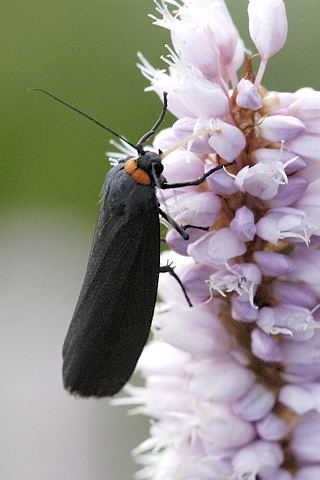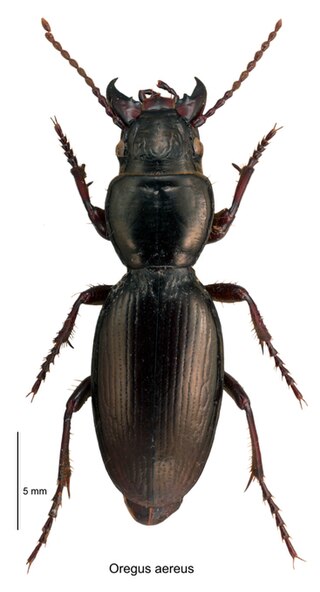
Tiger beetles are a family of beetles, Cicindelidae, known for their aggressive predatory habits and running speed. The fastest known species of tiger beetle, Rivacindela hudsoni, can run at a speed of 9 km/h, or about 125 body lengths per second. As of 2005, about 2,600 species and subspecies were known, with the richest diversity in the Oriental (Indo-Malayan) region, followed by the Neotropics. While historically treated as a subfamily of ground beetles (Carabidae) under the name Cicindelinae, several studies since 2020 indicated that they should be treated as a family, the Cicindelidae, which are a sister group to Carabidae within the Adephaga.

Ground beetles are a large, cosmopolitan family of beetles, the Carabidae, with more than 40,000 species worldwide, around 2,000 of which are found in North America and 2,700 in Europe. As of 2015, it is one of the 10 most species-rich animal families. They belong to the Adephaga. Members of the family are primarily carnivorous, but some members are herbivorous or omnivorous.

Ground squirrels are rodents of the squirrel family (Sciuridae) that generally live on the ground or in burrows, rather than in trees like the tree squirrels. The term is most often used for the medium-sized ground squirrels, as the larger ones are more commonly known as marmots or prairie dogs, while the smaller and less bushy-tailed ground squirrels tend to be known as chipmunks. Together, they make up the "marmot tribe" of squirrels, Marmotini, a clade within the large and mainly ground squirrel subfamily Xerinae, and containing six living genera. Well-known members of this largely Holarctic group are the marmots (Marmota), including the American groundhog, the chipmunks, the susliks (Spermophilus), and the prairie dogs (Cynomys). They are highly variable in size and habitus, but most are remarkably able to rise up on their hind legs and stand fully erect comfortably for prolonged periods. They also tend to be far more gregarious than other squirrels, and many live in colonies with complex social structures. Most Marmotini are rather short-tailed and large squirrels. At up to 8 kg (18 lb) or more, certain marmots are the heaviest squirrels.

The bean weevils or seed beetles are a subfamily (Bruchinae) of beetles, now placed in the family Chrysomelidae, though they have historically been treated as a separate family. They are granivores, and typically infest various kinds of seeds or beans, living most of their lives inside a single seed. The subfamily includes about 1,650 species and are found worldwide.

Cicindela, commonly known as common tiger beetles, are generally brightly colored and metallic beetles, often with some sort of patterning of ivory or cream-colored markings. They are most abundant and diverse in habitats very often near bodies of water with sandy or occasionally clay soils; they can be found along rivers, sea and lake shores, sand dunes, around dry lakebeds, on clay banks, or woodland paths.

The Danaini are a tribe of brush-footed butterflies. The tribe's type genus Danaus contains the well-known monarch butterfly and is also the type genus of the tribe's subfamily, the milkweed butterflies (Danainae).

The Phaegopterina are a subtribe of tiger moths in the tribe Arctiini, which is part of the family Erebidae. The subtribe was described by William Forsell Kirby in 1892. 469 species of Phaegopterina are present and 52 that are recently discovered in Brazil.

The Lithosiini are a tribe of lichen moths in the family Erebidae. The taxon was described by Gustaf Johan Billberg in 1820.

Ant nest beetles or paussines, some members of which are known also as flanged bombardier beetles, are a large subfamily within the ground beetles (Carabidae).The tribes Metriini, Ozaenini, Paussini and Protopaussini are included in the subfamily.

Chrysochroinae is a subfamily of beetles in the family Buprestidae: the "jewel beetles".

Protocollyris is a genus of tiger beetles in the family Cicindelidae, tribe Collyridini.
Neocollyris pacholatkoi is a species in the tiger beetle family Cicindelidae. It was described by Sawada and Wiesner in 2006 and is endemic to India.

The Aleocharinae are one of the largest subfamilies of rove beetles, containing over 12,000 species. Previously subject to large-scale debate whether the subfamily deserved the familial status, it is now considered one of the largest subfamilies of rove beetles.

The Pericopina is a subtribe of tiger moths in the family Erebidae. The subtribe was described by Francis Walker in 1869.

The Euchromiina are a subtribe of tiger moths in the family Erebidae. It was described by Arthur Gardiner Butler in 1876. Many species in the subtribe are mimics of wasps. Euchromiina have always been considered closely related to the subtribe Ctenuchina due to their similarity to moths and wasps. These two subtribes make up around 3,000 valid species, the majority of which occur in the Neotropics.

The tribe Broscini is a worldwide group of beetles in the Broscinae subfamily of Carabidae.

Zabrini is a tribe of ground beetles in the subfamily Pterostichinae of beetle family Carabidae, found mainly in North America and Europe. There are more than 750 described species in three genera of Zabrini, more than 600 of which are in the genus Amara.

Stenolophina is a subtribe of ground beetles in the family Carabidae. There are about 9 genera and at least 50 described species in Stenolophina.

Nothobroscina Roig-Juñent 2000 is one of five subtribes within the ground beetle tribe Broscini. The subtribe consists of ten genera from the Gondwanan countries: Australia, New Caledonia, New Zealand and southern South America. All of these genera are endemic to their respective country, i.e., none of the genera are shared across any of the Gondwanan countries.
The subtribe Creobiina is a group of beetles in the Broscini tribe of Carabidae and is found in Australia, New Zealand and South America.




















